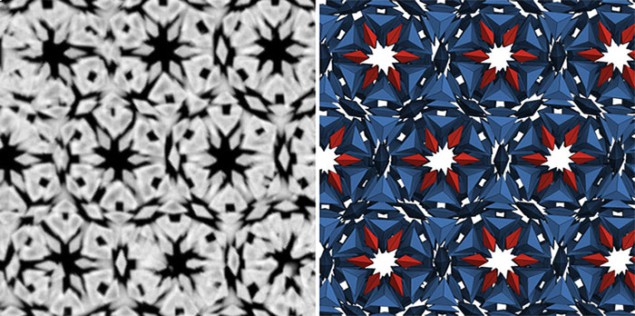Flash Physics is our daily pick of the latest need-to-know developments from the global physics community selected by Physics World‘s team of editors and reporters

Intricate gold crystals made with DNA
The most complex synthetic nanoparticle crystal ever made has been created using DNA and gold. Researchers have used gold nanoparticles and DNA “smart glue” to assemble intricate clathrate-crystal structures. There are many aspects of nature that scientists struggle to emulate in a laboratory. This includes a huge array of complex crystal structures such as clathrates. These cage-like lattices comprise polyhedral clusters and pores that can house small molecules. Such structures are useful for environmental applications where pollutants can be held within the pores. Recreating clathrates using nanoparticles is difficult because it relies upon precise nanoparticle shapes and dimensions. Yet a group of experimentalists and computer simulators has been able to both make and model the exact structure and assembly process when using gold nanoparticles and DNA glue. For more than a decade, Chad Mirkin from Northwestern University in the US and colleagues have pioneered the application of synthetic DNA strands to bond nanoparticles into programmable designs. For the study reported in Science, the researchers used gold-nanoparticle bipyramids. These look like two flattened tetrahedrons joined at their bases. The dimensions and angles of the nanoparticles created were ideal for forming clathrates, but the group found that if the DNA was too short, the bipyramids would assemble in disordered structures. Electron microscopy was used to image the resulting crystals and once clathrates were formed, the simulation team led by Sharon Glotzer of the University of Michigan in the US were able to accurately identify and model the crystal assembly. The resulting nanoparticle clathrates possess the cavities seen in natural systems, meaning they could be useful for environmental and medical diagnostic applications. Furthermore, as the dimensions of the nanoparticles are similar to visible-light wavelengths, the crystals may have potential in light-controlling devices such as new lenses, lasers and cloaking materials.
Microwave laser harnesses Josephson effect

A new type of microwave laser that is based on a Josephson junction has been unveiled by Leo Kouwenhoven and colleagues at the Delft University of Technology in the Netherlands. The device is similar to components already being used to develop superconductor-based quantum logic devices and could therefore play an important role in future quantum computers. A Josephson junction is a tiny gap in a superconducting circuit across which electron pairs can tunnel. When a voltage is applied across the barrier, the tunnelling pair can emit a microwave photon at a specific wavelength. The team’s Josephson junction is contained within a microwave cavity that is tuned to maximize the emission of microwave photons. These photons then bounce back and forth in the cavity, which stimulates the emission of even more photons. The cavity fills up with a coherent field of microwaves and some of the radiation can be removed as a coherent microwave laser beam. Unlike other microwave lasers, the device operates at extremely cold temperatures – making it suitable for use in superconductor-based quantum computers. The new laser is described in Science.
Borophene has Dirac cones after all

Borophene – a layer of boron just one atom thick – is more like graphene than previously thought, according to calculations and experiments done by an international team led by Iwao Matsuda at the University of Tokyo. Also just one atom thick, graphene has a unique set of electronic properties that arise from the fact that its atoms are arranged in a hexagonal lattice. Its valence and conductions bands are described by “Dirac cones” that touch, which means that graphene electrons behave as Dirac fermions that can travel at very high speeds through the material. In contrast, borophene can assume several different structures that do not have a perfect hexagonal lattice. As a result, some physicists had thought that borophene would not harbour Dirac fermions. Matsuda and colleagues calculated the electronic properties of a specific type of borophene – called β12 that forms when boron atoms are deposited on a silver substrate. This work suggested that this borophene should have Dirac cones and this was then backed up by angle-resolved photoemission spectroscopy experiments, which revealed that the borophene cones are actually split into pairs (see figure). Writing in Physical Review Letters, Matsuda and colleagues suggest that like graphene, borophene could be used to create high-speed electronic devices.
- You can find all our daily Flash Physics posts in the website’s news section, as well as on Twitter and Facebook using #FlashPhysics. Tune in to physicsworld.com later today to read today’s extensive news story on a new source of ultrasound.



